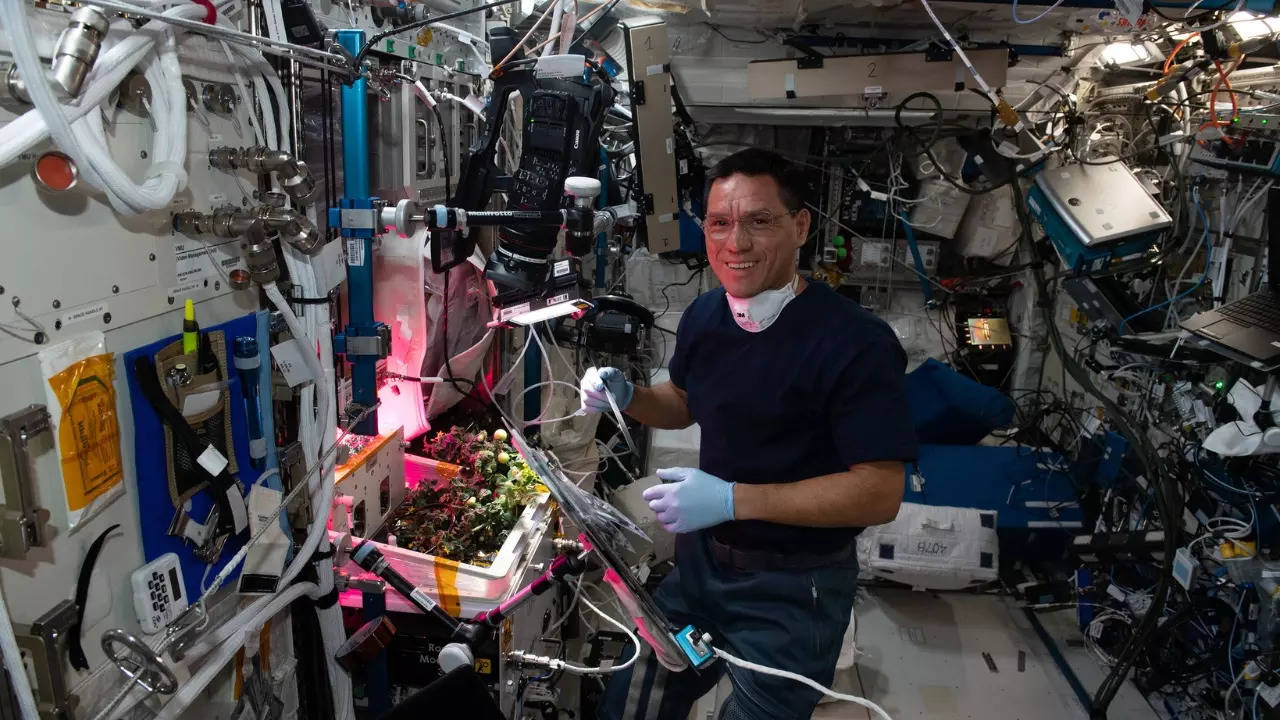International Space Station Finds Lost Tomato Missing for 8 Months
During an off-Earth harvest aboard the International Space Station (ISS) in March, NASA astronaut Frank Rubio lost a tomato and had since been accused of eating it. The runaway space-grown fruit has finally been found after 8 months of disappearance, the Expedition 70 crew confirmed in a 25th anniversary livestream.

Astronaut Frank Rubio checks tomato plants growing as part of a botany study aboard the International Space Station. Courtesy: Koichi Wakata/Japan Aerospace Exploration Agency
KEY HIGHLIGHTS
- Astronauts aboard the International Space Station have found a space-grown tomato that was lost 8 months ago.
- The tomato went missing on March 29, when Frank Rubio was harvesting the plants grown in a NASA experiment.
- The astronaut has been cleared of any accusations he ate the fruit after it was rediscovered by the current crew.
Eight months after NASA astronaut Frank Rubio lost a tomato aboard the International Space Station (ISS), he has finally been cleared of any suspicions of eating it.
During a livestream celebrating the 25th anniversary of ISS operations on December 6, crew members of the Expedition 70 announced that the tomato had been found.
"Our good friend Frank Rubio, who headed home, has been blamed for quite a while for eating the tomato,” astronaut Jasmin Moghbeli said. “But we can exonerate him. We found the tomato."
The tomato, a 1-inch Red Robin dwarf, was part of an off-Earth harvest carried out on March 29. Rubio misplaced it in the space station’s plant growth unit Veggie, where NASA studies the effects of microgravity on plants.
The astronaut left the orbital outpost for Earth in September, however not before spending hours looking for the tomato that had been grown without soil in a groundbreaking experiment, he revealed in an ISS livestream at the time.
"I'm sure the desiccated tomato will show up at some point and vindicate me, years in the future,” he said.
“The humidity up there's 177%, and so it probably desiccated to the point where you couldn't tell what it was”
Rubio had since been the target of joking allegations that he ate the fruit, despite clear instructions from NASA not to eat it due to the risk of a potential fungal contamination.
The tomato was found eight months later, however it remains unknown whether his fellow astronauts discovered it in Veggie or someplace else.
The current crew also left out the details of the tomato’s state while speaking to NASA Associate Administrator Bob Cabana, who was the commander of space shuttle Endeavour’s pioneering 1998 mission to the International Space Station, during Wednesday’s Q&A.
It is understood that the tomato had decayed significantly in the humidity, as predicted by Rubio.
Tomatoes aren’t the only plants that NASA has grown on the ISS. A potato was the first vegetable to grow in space in 1995, leading up to a series of successful harvests including lettuce, kale and cabbage.
End of Article
Subscribe to our daily Newsletter!
Videos





03:18
Amitabh Bachchan's Heartwarming Moment with Grandson Agastya Nanda in front of his Fans

02:10
Raveena Tandon addresses CONTROVERSIAL statements regarding Khushi Kapoor and Agastya Nanda in The Archies

02:27
iQOO 12 5G | Glimpse of Exciting Leaks! | Funtouch OS Android 14, Qualcomm Snapdragon 8Gen3 & More

02:15
OnePlus 12 Design & Looks | OnePlus 12 Latest Updates | OnePlus 12 Colour Available | Gadget Times

03:53
Urfi Javed Flaunts her Topless Style | Jennifer Mistry's HEARTWARIMNG note for TMKOC













